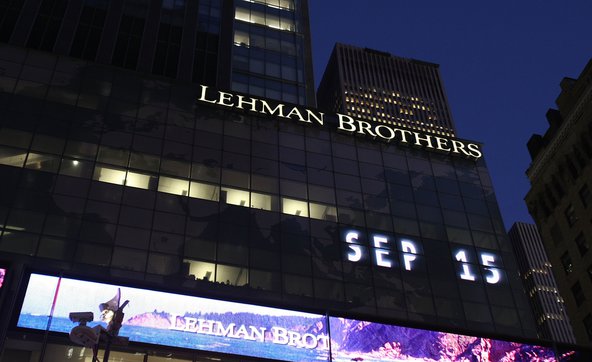Lehman’s lessons, ten years on
by Professor Colin Mayer FBA
15 Sep 2018
This month marks the tenth anniversary of the global financial crisis. On 15 September 2008, Lehman Brothers declared bankruptcy. It came after a weekend of frantic negotiation in which hopes of a possible acquisition of Lehman Brothers by Barclays Bank waxed and waned, leaving the bank with a substantial liquidity shortfall and $40bn of bad assets on its balance sheet. It was said of Lehman Brothers that, “there was nothing right on the left-hand side of its balance sheet and nothing left on the right-hand side”.
Lehman Brothers’ rise and fall
It was a rags to riches to rags story of a bank that started its life as a grocery store in Montgomery, Alabama in 1844. Lehman Brothers moved into investment banking in 1906 as an underwriter of securities and grew to become the fourth largest investment bank in the US by the 21st century. Two of its early clients as an investment bank were Sears, Roebuck & Co., and F.M Woolworth Co. Retailing was just one of the US industries that Lehman Brothers helped to shape and reshape in the 20th century; aviation, computing and entertainment were some of the others.
The immediate source of the demise of Lehman Brothers was real estate and the sub-prime market, targeting borrowers of poor credit risks. US house prices peaked in the summer of 2005 and by February 2007 the subprime mortgage market had collapsed. Lehman Brothers borrowed short-term in the overnight repo market and lent long into the subprime market. It was therefore a highly leveraged structure that involved converting liquid borrowings into relatively illiquid assets, short-term liabilities into long-term assets, and relatively safe liabilities into risky assets.
These are the traditional banking functions of liquidity, maturity and credit transformation. Their success in performing these functions depends on their ability to pool their loans and take advantage of diversification to reduce the risks of their assets. It also depends on the continuing trust of banks’ lenders in the soundness of their operations. With the collapse of the real estate and subprime mortgage markets, that confidence evaporated and Lehman Brothers faced the double squeeze of failing loans and eroding funds.
Understanding the problem
Since the financial crisis we have come to appreciate that incentives on banks to engage in such risk taking activities are distorted by the systemic consequences of their failures and the burdens they impose on nation states and taxpayers. The response has been the strengthening of bank regulation and the imposition of more stringent capital and liquidity requirements.
What is less well appreciated is that the experience of Lehman Brothers and the banking system in 2008 is symptomatic of a much more general problem : a conflict between the owners of corporations, their shareholders, and other parties to the firm. There were incentives on banks to engage in excessive risk taking not just because of their public subsidies from deposit insurance schemes, lender of last resort facilities and “too big to fail” interventions, but also from their inherent structures.
The objective of companies in maximising shareholder interests is hardwired into corporate law, corporate governance, performance measurement, executive remuneration, and institutional engagement and activism. The success of a company is conventionally measured in terms of its share price, and the remuneration and retention of directors are directly influenced by it.

The Lehman Brothers Holdings Inc. headquarters in New York City on 15 September 2008. Photo by Mario Tama/Getty Images.
Conflicts of interest
Under UK company law, directors should take account of the interests of other parties to the extent that they promote the success of their companies for the benefit of their shareholders. They have a further duty to their creditors when they are in financial distress. However, these are secondary to the primary duty of directors to shareholders in normal times.
As a consequence, there is an inherent conflict between the interests of different parties to the firm. This is particularly pronounced in highly leveraged organizations such as Lehman Brothers whose underlying business model is to trade on the risks of their creditors for the benefit of their shareholders. But it is present in all corporations to varying extents, not just in relation to their financial creditors but also their other dependent parties, including their employees, suppliers, customers and communities
This raises questions about limited liability and the governance of companies. For example, one of the responses to the financial crisis has been a call to strengthen corporate governance of banks. However, evidence from the financial crisis records that it was the banks with the best governance arrangements in terms of their board structures, and the highest powered executive incentives in relation to their share prices, that failed the most. That is not surprising in the context of corporate governance that strengthens relations between shareholders and management at the expense of other parties.
In particular, it points to the importance of aligning corporate purpose with public responsibilities in companies that are of greatest social relevance – utilities, companies with significant market power and banks – where potential conflicts between shareholder and wider social interests are largest. This is what legislative reforms such as the “benefit corporation” in the US seek to do. To date, these reforms have been primarily focused on relatively small companies. What this suggests is that the greatest relevance of benefit corporations might be at exactly the opposite end of the spectrum, in the largest and most important companies in an economy – the “commanding heights”, as they are sometimes termed.
Lehman Brothers was certainly at the commanding heights of not just the US economy but also many around the world. That made the significance of its fall for the global economy all the greater and the case for aligning corporations’ private interests with those of customers, creditors and societies through legislation all the stronger. With a fiduciary duty on its directors to uphold a public licence to operate, the Lehman story might have had a very different ending, or indeed, no ending at all.
Colin Mayer is Peter Moores Professor of Management Studies, Said Business School, University of Oxford, and Academic Lead of the British Academy Future of the Corporation programme
The conclusions of the first phase of the British Academy programme on the Future of the Corporation will be published on 1 November 2018.
Professor Mayer’s book Prosperity: Better Business Makes the Greater Good will be published by Oxford University Press in November of this year.


